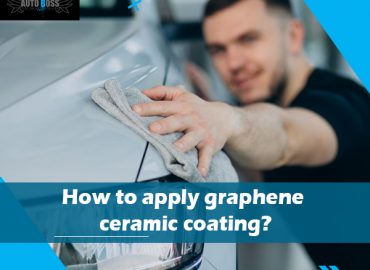Paint correction is a process of auto detailing that helps remove minor scratches, swirl marks, marring, hazing and blemish from the car’s clear coat. It is the process in which auto detailers use polishing solutions and machines to remove a clear coat’s microscopic layer. It is done to make the surface smooth and shiny.
Correcting paint is quite difficult to define. Some people use this term interchangeably with Polish. However, both words are not the same. We will discuss here the process of paint correction in detail.
Paint correction purpose
This process aims to remove car paint’s imperfections and restore its original shine. When the car owner considers the money, time and effort put into ensuring the car’s appearance is spotless and clean. However, if you don’t maintain it regularly, your car will turn dull.
Optimal Swirl-free finishes
An optimal swirl-free finish is the maximum possible paint correction standard. You can achieve this by a combination of wax and polish. It is a dual-action process to remove imperfections and light scratches from your car paint.
How to get the finest paint correction results?
You can achieve the best correction results using the finest-quality compound, polishing pad, wax, polish or sealant. It would help if you considered using a DA polisher or rotary.
If you are a starter at paint correction, we suggest a rotary polisher that is relatively easier to use. However, DA machines are advanced and need more experience for optimal results. If you are thinking about excellent results but don’t have much money to spend purchasing products and tools.
What does car paint consist of?
Car paint combines a primer, a base paint coat and a transparent coating layer. The car primer is applied to prepare your vehicle for using color. You may apply a base coat on the car primer to give a car color. Finally, the last layer of clear coat is applied. It is a final shiny and protective finish.
The steps involved in car paint are:
Media blasting: Preparation stage
The preparation stage removes rust, flaws and contaminants from the car surface. The car detailers use pressurized air to material’s tiny particles (e.g., plastic beads or walnuts). It is essential for preparing the car body for a smooth paint finish.
Apply primer coat
Applying the primer is the next step in preparation. The primer is paint made of solvent, resin and additives that prepare the car surface for the original car paint. You may require a primer coat to even the car’s exterior and remove flaws. Primer protects the car body from extreme heat, rust, stone shards and UV rays.
Base coat
Applying a base or color coat is the third phase of painting your vehicle. It is actual paint that is used on primers. t is available in four types.
- Metallic
- Pearlescent
- Matte
- Solid
Each coat owns unique properties and provides separate finishes to your car.
Clear coat
Precise coat application is the final step in automobile painting. The final coat preserves the base coat from external damage or UV damage. Ensure the clear coat is durable and long-lasting. Keep it strong with proper maintenance, waxing and polishing.
Compounds and tools to be used
Machine polisher
It is used to polish car paint and remove scratches. It makes your car paint smooth and increases its lifespan.
Polishing pads
These attachments to the machine polisher are used to remove stains, scratches and swirls. Polishing pads come in many sizes and materials, including wool, microfiber and foam.
Foam pads are better for casual use and are easy to work with. Microfiber can work harder than ceramic coats. However, woolen pads generate low-level heat and have better results.
Compound or polish
It serves as a vital chemical. Compounds are aggressive. Professional detailers use compounds to remove etching and heavy scratches. Polishing is less fierce. It is used to get rid of marks and light scratches.
Paint sealant
It is a synthetic polymer that repels external elements such as acidic rain, excessive heat and UV rays protection.
How to paint correction work?
A professional car detailer uses a microfiber buffing pad, an electric polisher and a buffing compound that works on the car’s clear coat until you get rid of scratches.
Clean your work spot
Removing contaminants from the car surface is essential for better results. Decontamination removes sap, dirt or insects that may obstruct the paint correction.
Professional detailers use a spray, iron remover or clay bar to ensure deep cleaning.
Analyzing the scratches
When your car paint is clean, you can quickly identify the scratches and their causes. You can fix swirls and scratches with a remover or a polish coat.
Suppose you observe damages in base coats. You will require a paint touch-up.
Level up the surface
Use a microfiber cutting pad for properly leveling up the surface using this process.
Then buff the area with a cutting compound and microfiber cutting pad on an electric polisher.
When the pad is torn or worn out, replace it with a new one. We suggest you change the cutting pad after every six square feet.
Repeat the whole process.
Polishing
Use polishing to remove marks, scratches and blemishes on car paint without damaging the car’s original color.
Recoat the vehicle
Once the polishing process completes successfully, apply a reinforcement layer of paint to the clear coat. You can also use nano ceramic coatings to protect it from scratches and damage.
Conclusion
Improper car wash or drying can create micro-marring or scratches on the car’s surface. It is the reality that car paint faces wear and tear with time. Once you notice paint color fainting, it is the accurate time to get a paint correction. Auto boss Vaughan car detailers help you with the best-ever automotive paint processes.
Correcting paint permanently removes hazing, swirl marks, and scratches on your clear coat. Although wax and polish may leave a good finish, they do not help remove surface defects. Automotive wax can hide swirl issues but improves the car’s finish. It is a deep process that provides the best results regarding paint appearance.
FAQS
Is paint correction the right decision?
Yes! Paint correction is a crucial part of the auto detailing process. It helps maintain the shine of your vehicle. Micro-marring or scratches are the reasons for visible imperfections on your car.
Are car polishing and paint correction the same?
No! Car polishing is a process of enhancing your car’s paint. However, correcting color is a defect-removing process.
Does paint correction damage the car’s original paint?
Correcting paint does not create paint damage. If you go for too much paint correction, it may damage the paint. If you remove a thick layer of paint, it may cause apparent coat failure.
Can paint correction help in fixing scratches?
Paint correction removes hazing, scratches, swirl marks and imperfections on your car’s surface.




